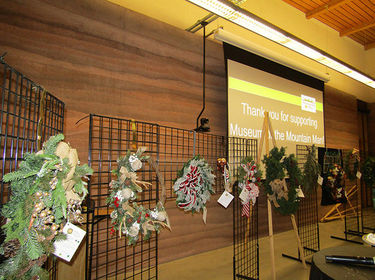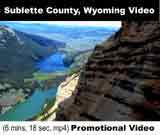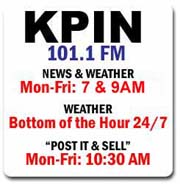|
Windstorms cause almost 40 blow-over crashes in three days (posted 12/13/2025)
Wyoming Department of Transportation
CHEYENNE, WYOMING – The ongoing high wind event has caused 39 vehicles to crash on Wyoming highways so far this week, especially Dec. 9-11. With winter being the state’s windiest months, the Wyoming Department of Transportation and Wyoming Highway Patrol want to remind drivers of all vehicle types to use caution and pay close attention to highway signage.
Most crashes occurred on Interstate 80 near Cooper Cove west of Laramie, Interstate 25 on Wyo Hill south of Cheyenne, and I-25 near Wheatland at Bordeaux. Many blown-over vehicles were underweight, and some trailers were even empty.
WYDOT updates the minimum weights listed on overhead digital messaging signs based on real-time wind speeds. Drivers should check weight-based wind closure information often to ensure travel is permitted.
It’s not just commercial vehicles that are at risk – campers, toy-haulers and other large trailers are also susceptible to blowing over in strong winds.
Drivers can check wind closures and wind speeds anytime at www.wyoroad.info or via the Wyoming 511 mobile app.
During powerful wind events, WYDOT and the Wyoming Highway Patrol urge all travelers to heed wind closure warnings. Driving a prohibited vehicle during these closures can lead to hefty fines, including fines for any damage to the roadway. In addition, a single blow-over event often occupies several troopers, along with additional towing and emergency vehicles, tying up critical resources that may be needed elsewhere and sometimes forcing the highway to close to all traffic for debris cleanup.
Vehicles not included in wind restrictions should use caution on windy days, too. Stay alert for blowing snow, slick spots and other potential hazards.
Crash totals and details are preliminary, and final totals may change as crash reports are processed.
Governor Gordon advances consideration of Sublette antelope migration corridor (posted 12/13/2025)
Applications for local working group members accepted until Dec. 31
Governor Gordon media release
CHEYENNE, WYOMING - Governor Mark Gordon (R-WY) announced today (December 10, 2025) that he will proceed with the consideration of the Sublette antelope migration corridor, following the recommendation from the Wyoming Game and Fish Commission to officially designate the pathway.
"My determination is that work on the Sublette Antelope Migration Corridor will proceed, with focus on the Wyoming Game and Fish Department’s recommendation of the eight segments within the identified corridor for designation consideration, including North, Bondurant, Foothills, East of WY -191, Central, Southwest, Fontenelle, and Calpet. This decision is underscored by the best available scientific information on the value, conservation risks and opportunities detailed along these routes," Governor Gordon said.
The Governor’s actions follow steps outlined in the Executive Order 2020-1 (EO), Wyoming Mule Deer and Antelope Migration Corridor Protection. The Wyoming Game and Fish Commission identified the Sublette antelope corridor in March 2025, the first step in the official Corridor Designation and Review Process. The Commission voted to advance the corridor for designation to the Governor in September 2025.
Next the Governor will appoint a local working group to analyze and evaluate the corridor. As outlined in the EO, the local working group will be composed of an appointed representative from each county affected, to include Teton, Sublette, Lincoln, and Sweetwater.
"The Migration Corridor Conservation Strategy established by the Executive Order creates a state-led approach to support conservation for mule deer and pronghorn migration while preserving multiple-use opportunities for the State of Wyoming. I look forward to the next steps as the corridor is reviewed and elevated by a diverse local working group," Governor Gordon said.
The Governor has opened an application process for prospective representatives from the following groups, as detailed in the EO:
• Agriculture (2 representatives)
• Industrial users - oil, gas, mining and renewable (2 representatives)
• Wildlife/conservation/hunting (2 representatives)
• Motorized recreation (1 representatives)
The local working group is ultimately charged with reviewing the Game and Fish’s risk assessment, corridor components, potential impacts to socio-economic conditions of the region, conservation opportunities, highway projects, and other factors appropriate to the potential designation. Following their analysis, the working group will make a final recommendation to Governor Gordon, who has the authority to either designate the corridor, return the recommendation to Game and Fish for refinement, or reject the proposal for designation.
Applications for the working group will be accepted until Wednesday, Dec. 31. Following the Governor will review prospective representatives and make final appointments. Questions regarding the local working group and process should be directed to Sara DiRienzo, deputy director of policy at sara.dirienzo1@wyo.gov.
Volunteers sought for National Midwinter Bald Eagle Survey (posted 12/13/2025)
Pinedale Survey January 10, 2026
Bureau of Land Management
The Bureau of Land Management Kemmerer and Pinedale field offices are inviting volunteers to participate in the national Midwinter Bald Eagle Survey. The Kemmerer survey is scheduled for Friday, Jan. 9, while the Pinedale survey will take place on Saturday, Jan. 10.
Volunteers should call the Kemmerer and Pinedale field office by Wednesday Jan. 7, 2026, to be assigned survey routes along public roads in Sublette and Lincoln Counties in Wyoming and to receive instructions on survey methods and eagle identification. The Kemmerer field office will add an additional route in the Star Valley area of Lincoln County. Two-person observation teams are needed so one person can safely drive while the other observes and documents eagles.
Since 1979, federal and state agencies as well as volunteers from the public have counted bald eagles throughout the United States every January. By monitoring and estimating national and regional count trends, an index of the total winter bald eagle population in the lower 48 states has been established.
For additional information:
• Pinedale Field Office: Contact Theresa Gulbrandson at 307-367-5359.
• Kemmerer Field Office: Contact David Merz at 307-828-4556.
Update on July 2025 Shooting Investigation (posted 12/11/2025)
Sublette County Sheriff’s Office
The Sublette County Sheriff’s Office is providing an update regarding the July 11, 2025, shooting incident involving Paul Browning and Craig Rice. A Special Prosecutor was appointed by the Sublette County Board of County Commissioners as a result of an ethical conflict prohibiting review by the Sublette County Attorney’s Office. Dan Itzen, Natrona County District Attorney, the appointed special prosecutor has completed an independent review of the July 11, 2025, shooting incident in Pinedale and determined that no criminal charges will be filed.
Following a review of the completed investigation conducted by the Sublette County Sheriff’s Office, the Special Prosecutor focused on the immediate circumstances of the confrontation, the actions of both individuals, and the physical evidence collected at the scene. His review determined that Mr. Browning’s behavior, verbal threats, and the object he was holding created conditions that could reasonably be interpreted as presenting an imminent threat to Mr. Rice. These factors, along with the rapid escalation of the encounter, and the proximity between the two men formed the basis for the conclusion that Mr. Rice’s response was consistent with self-defense under Wyoming law.
This concludes the criminal review of the case.

|
Someone has a $2.2 million lottery ticket bought from the Daniel Junction Foodmart in Sublette County (posted 12/10/2025)
Check your numbers
Pinedale Online!
On Monday, December 8th, the Wyoming Lottery pulled a Cowboy Draw ticket at the Daniel Junction Foodmart in Sublette County that won $2,277,420. The WyoLotto Millionaire winning numbers were 1-10-22-31-39. Numbers can be checked here: https://wyolotto.com/wyo-wins/check-your-numbers/
As of the time of this report, the winner’s name has not been identified. Winners can choose to remain anonymous.
Related Links:
Daniel Junction Foodmart Store Sells $2.2 Million Wyoming Lottery Ticket By Jimmy Orr, Cowboy State Daily, December 9, 2025
www.wyolotto.com Wyoming Lottery
Christmas tree permits available in Wyoming (posted 12/6/2025)
Cost of permit is $1 per tree
Bureau of Land Management
CHEYENNE, WYOMING – Christmas tree permits are available online at https://forestproducts.blm.gov. The cost for a permit is $1 per tree, depending on location. Up to a maximum of three Christmas trees can be purchased by an individual for personal use.
Permits may also be purchased between 7:45 a.m. and 4:30 p.m., Monday-Friday from your local BLM Wyoming field offices, excluding the Newcastle and Cody Field Offices.
A BLM permit is valid for trees located on BLM-administered lands only. Permits for trees on U.S. Forest Service-administered land can be obtained at your local Forest Service office and at some BLM offices.
Permit Guidelines:
• Trees must be less than 15 feet tall and have a diameter at breast height of less than 8 inches.
• Permit holders must carry a valid permit when cutting trees.
• Trees may not be harvested from wilderness areas, wilderness study areas, timber sale areas, campgrounds, or boat access sites.
• Cutting is not permitted on private land; please ensure you’re on BLM managed land and avoid trespassing.
• Be prepared for winter weather and high-country conditions.
Protected Species:
• All pines with needles in bundles of five, such as whitebark pine (Pinus albicaulis) and limber pine (Pinus flexilis), are protected and must not be cut or damaged.
Local Tree Recommendations:
• Local tree species, including subalpine fir, Engelmann spruce, Douglas-fir, ponderosa pine, and lodgepole pine make excellent Christmas trees and are often found growing in the understory of aspen stands.
• Christmas trees harvested from aspen stands and dense young stands will contribute to forest health and improve wildlife habitat.
For additional information, visit www.blm.gov/wyoming-christmas-trees or contact your local BLM office:
• Buffalo Field Office (307) 684-1100
• Casper Field Office (307) 261-7600
• Kemmerer Field Office (307) 828-4500
• Lander Field Office (307) 332-8400
• Pinedale Field Office (307) 367-5300
• Rawlins Field Office (307) 328-4200
• Rock Springs Field Office (307) 352-0256
• Worland Field Office (307) 347-5100
Seasonal closures approach for WHMAs (posted 11/28/2025)
Wyoming Game and Fish Department
CHEYENNE, WYOMING — Seasonal closures for Wyoming Game and Fish Department Wildlife Habitat Management Areas are in place or will be enforced soon. These closures are important in protecting wildlife on their winter range.
"Seasonal closures are essential for minimizing stress-causing disturbances to wintering deer, elk, bighorn sheep and other wildlife," said Ray Bredehoft, Game and Fish Deputy Chief of Services. "These closures also reduce the human and recreational impacts to forage, which supports wildlife on their winter ranges."
Game and Fish maintains more than 500,000 acres of land through WHMAs. The areas include access to nearly 225 miles of streams, more than 21,000 lake surface acres and more than 148 miles of road right-of-ways. Management of these areas plays an important role in maintaining healthy winter habitats for species.
Closure dates of WHMAs can vary. For specific area details, visit the WHMA page on the Game and Fish website (https://wgfd.wyo.gov/Public-Access/WHMA.
The page contains maps, general regulations and rules governing each unique area.
Here are the WHMA’s in the Pinedale area:
Half Moon Pinedale Dec. 1-April 30 Closed to human presence.
Soda Lake Pinedale Dec. 1-April 30. Closed to human presence.
Fall Creek Pinedale Dec. 1-April 30. Closed to human presence.
Luke Lynch Pinedale Nov. 1-April 30.
Closed to vehicle traffic Nov 1-Dec 1. Closed to all human presence Dec 1- April 30.
Black Butte Pinedale Dec. 1-April 30. Closed to human presence.
Source and more info: https://wgfd.wyo.gov/news-events/seasonal-closures-approach-whmas
Commercial Fishing boat registration opens Dec. 1 (posted 11/28/2025)
Wyoming Game & Fish
CHEYENNE, WYOMING — Beginning Jan. 1, all boats providing commercial fishing guide services on Wyoming waterways will be required to display commercially-guided fishing boat registration stickers on the stern of the watercraft and tongue of the watercraft trailer.
The new registration stickers become available Dec. 1 through the Wyoming Game and Fish Department license page. Beginning Jan. 2, the stickers also will be available at Game and Fish regional offices and at the Cheyenne Headquarters office.
Following the passage of Wyoming House Bill 005, which was signed into law earlier this year, Game and Fish appointed a commercially-guided fishing boat advisory board to help the department develop recommendations for commercially-guided fishing boat registration requirements. The board and department met multiple times to develop the new Commercially Guided Fishing Boats, Chapter 71, which the department brought to the Wyoming Game and Fish Commission in September where it received final approval.
Per the new regulations, operators of commercially-guided fishing boats will be required to display the stickers on the boat and trailers when they are being used to guide anglers. The cost for the two stickers is $325. This fee is a flat rate for resident and nonresident commercial anglers.
Registrants will be provided with identifying decals to attach to the trailer tongue and the starboard/right side of the boat near the stern/rear. They also will receive a vehicle dashboard slip that must be displayed on the dashboard of the vehicle that is being used to guide anglers.
Those purchasing the stickers will be required to submit reports to the department twice each year that detail where guided trips were taken and when. Registrants will be able to complete these reports on the department website.
The registration stickers will need to be renewed annually. Proof of purchase received at the time of sale will serve as proof of registration for 30 days, giving the department time to ship decals and dashboard slips to the purchaser.
Recovering road-killed wildlife on Wyoming roads requires authorization from Game and Fish (posted 11/28/2025)
Wyoming Game and Fish Department
The Wyoming Game and Fish Department wants to remind the public that recovering road-killed wildlife requires authorization. People need approval from Game and Fish prior to collection through the Wyoming 511 app. Authorization for the collection can be done through the app, even without cellular service.
The public can request authorization to salvage deer, elk, pronghorn, moose, wild bison and wild turkey from unintentional vehicle collisions.
A person who is authorized to collect roadkill must abide by the safety guidelines outlined within the regulation:
• Only take road-killed wildlife from a public road or highway from sunrise until sunset.
• Parking off the road is required and emergency flashers must be used.
• No field dressing of any kind is permitted on the roadway.
• The whole animal must be taken and the inedible portions must be properly disposed of in an approved landfill.
Safety considerations prohibit people from picking up carcasses from extremely busy roadways, such as interstates 25, 80 and 90. It also disallows collection in active construction areas and within national parks in Wyoming.
To request authorization through the Wyoming 511 app, look for the "Report Roadkill" button on the homescreen. If the species is available for collection in an approved location, the user can request authorization. The app immediately sends a certificate upon completing the questionnaire. Requestors must have or create a username and password with the Game and Fish to gain authorization.
Full collection guidelines and the regulation is available on the Game and Fish website.
Source: https://wgfd.wyo.gov/news-events/recovering-road-killed-wildlife-wyoming-roads-requires-authorization-game-and-fish-0
BLM Pinedale field office to conduct prescribed burns (posted 11/21/2025)
Bureau of Land Management
PINEDALE, WYOMING — There is the potential for the Bureau of Land Management to conduct prescribed burns on multiple lands managed by the Pinedale Field Office and agency partners this fall and winter. This is contingent upon fuel moisture and weather meeting optimal burn conditions. The treatments will only be implemented if specified prescription parameters are obtained.
The prescribed burning of piles will dispose of slash from the following projects:
New Fork Fuels Treatment: The New Fork pile is located on a small, isolated parcel of BLM administered land to the southwest of New Fork Lake in Sublette County, Wyoming, one mile southwest of New Fork Lake off the New Fork Lake Road. A total of 17 acres of hand and machine piles will be targeted this year. This project reduces hazardous fuels, increases forest health, and provided firewood to the public through BLM firewood gathering permits.
Deadline Ridge Fuels Treatment: The entire Deadline Ridge project is in Sublette County, Wyoming, approximately 11 miles northwest of La Barge, Wyoming. There are nine targeted units located between Beaver Dam Creek and South Fork Dry Piney Creek on the east slope of Deadline Ridge. In total, 129 acres are targeted for ignition and consist of hand created slash piles. The treatment will stimulate aspen growth and available forage for big game in critical migration corridors and reduce hazardous fuels on the landscape.
Burdick Fuels Treatment: The Burdick project is in Lincoln County, Wyoming, approximately 10 miles west of La Barge, Wyoming. The project is on the northern portion of Miller Mountain, near the head of Burdick Creek drainage. The 203 acres of hand created slash piles will be targeted for ignitions. The treatment will stimulate aspen growth and available forage for big game in critical migration corridors and reduce hazardous fuels on the landscape.
Prescribed burns conducted by the BLM follow strict approval, permitting and environmental review processes. Each project includes design features and mitigation measures to meet treatment goals while limiting impacts to other resources. Every burn is carried out under a detailed prescribed fire plan, with public and firefighter safety as the top priority. While no vegetation treatment is risk-free, the planning process works to reduce risk as much as possible. High Desert District fire and fuels crews may also assist partner agencies and landowners with additional treatments.
During operations, smoke may be visible from long distances but should clear quickly, depending on weather, fuel conditions and the amount of material being treated. Hunters, recreationists and other public land users should be aware of project locations and ongoing prescribed fire activity.
For more information, contact either Pinedale Field Office Fuels Specialist Ross Dary at (307) 231-5935 or HDD Fire Management Officer Mark Randall at (307) 367-5350. For more information about BLM Wyoming, visit https://www.blm.gov/wyoming or follow BLM Wyoming on social media (X or Facebook).
|
Business
Directory
|










